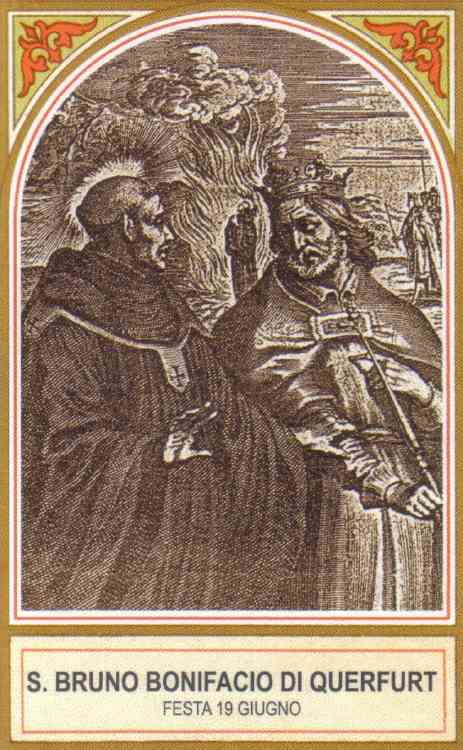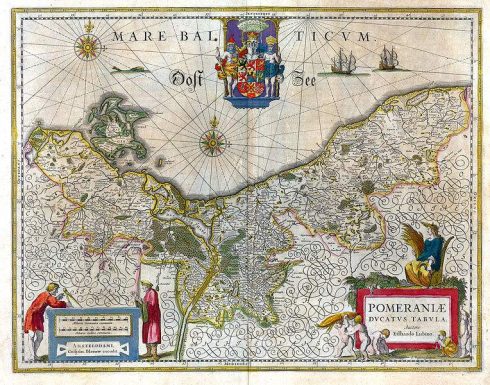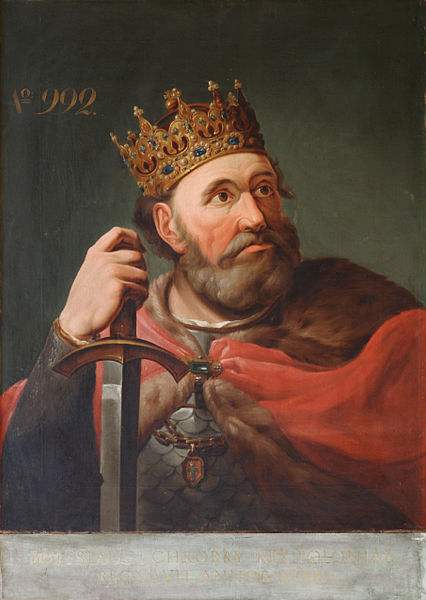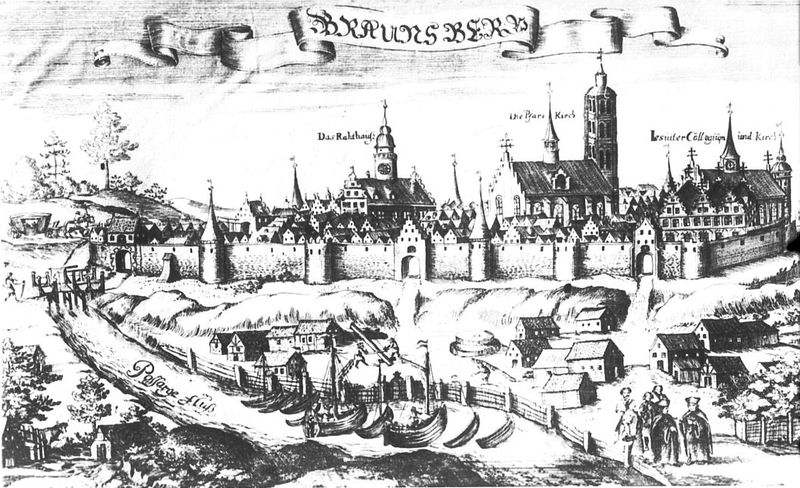St. Bruno of Querfurt
(Also called BRUN and BONIFACE).
 Second Apostle of the Prussians and martyr, born about 970; died 14 February, 1009. He is generally represented with a hand cut off, and is commemorated on 15 October. Bruno was a member of the noble family of Querfurt and is commonly said to have been a relative of the Emperor Otto III, although Hefele (in Kirchenlex., II, s.v. Bruno) emphatically denies this. When hardly six years old he was sent to Archbishop Adalbert of Magdeburg to be educated and had the learned Geddo as his teacher in the cathedral school. He was a well-behaved, industrious scholar, while still a lad he was made a canon of the cathedral. The fifteen year-old Otto III became attached to Bruno, made him one of his court, and took him to Rome when the young emperor went there in 996 to be crowned. At Rome Bruno became acquainted with St. Adalbert Archbishop of Prague, who was murdered a year later by the pagan Prussians to whom he had gone as a missionary. After Adalbert’s death Bruno was tied with an intense desire for martyrdom. He spent much of has time in the monastery on the Aventine where Adalbert had become a monk, and where Abbot Johannes Canaparius wrote a life of Adalbert. Bruno, however, did not enter the monastic life here, but in the monastery of Pereum, an island in the swamps near Ravenna.
Second Apostle of the Prussians and martyr, born about 970; died 14 February, 1009. He is generally represented with a hand cut off, and is commemorated on 15 October. Bruno was a member of the noble family of Querfurt and is commonly said to have been a relative of the Emperor Otto III, although Hefele (in Kirchenlex., II, s.v. Bruno) emphatically denies this. When hardly six years old he was sent to Archbishop Adalbert of Magdeburg to be educated and had the learned Geddo as his teacher in the cathedral school. He was a well-behaved, industrious scholar, while still a lad he was made a canon of the cathedral. The fifteen year-old Otto III became attached to Bruno, made him one of his court, and took him to Rome when the young emperor went there in 996 to be crowned. At Rome Bruno became acquainted with St. Adalbert Archbishop of Prague, who was murdered a year later by the pagan Prussians to whom he had gone as a missionary. After Adalbert’s death Bruno was tied with an intense desire for martyrdom. He spent much of has time in the monastery on the Aventine where Adalbert had become a monk, and where Abbot Johannes Canaparius wrote a life of Adalbert. Bruno, however, did not enter the monastic life here, but in the monastery of Pereum, an island in the swamps near Ravenna.

Map of the lands given St. Bruno in 1003 were in the region shown on left bank of the Oder, Hither Pomerania along the coast, or the future Margraviate of Brandenburg to its south.
Pereum was under the rule of the founder of the Camaldoli reform, St. Romuald, a saint who had great influence over the Emperor Otto III. Under the guidance of St. Romuald Bruno underwent a severe ascetic training; it included manual work, fasting all week except Sunday and Thursday, night vigils, and scourging on the bare back; in addition Bruno suffered greatly from fever. He found much pleasure in the friendship of a brother of the same age as himself, Benedict of Benevento, who shared his cell and who was one with him in mind and spirit. The Emperor Otto III desired to convert the lands; between the Elbe and the Oder, which were occupied by Slavs, to Christianity, and to plant colonies there. He hoped to attain these ends through the aid of a monastery to be founded in this region by some of the most zealous of Romuald’s pupils. In 1001, therefore, Benedict another brother of the same monastery, Joannes, went, laden with gifts from the emperor, to Poland, where they were well received by the Christian Duke Boleslas, who taught them the language of the people. During this time Bruno studied the language of Italy, where he remained with Otto and awaited the Apostolic appointment by the pope. Sylvester II made him archbishop over the heathen and gave him the pallium, but left the consecration to the Archbishop of Magdeburg, who had the supervision of the mission to the Slavs. Quiting Rome in 1003, Bruno was consecrated in February, 1004, by Archbishop Tagino of Magdeburg and gave his property for the founding of a monastery. As war has broken out between Emperor Henry II and the Polish Duke, Bruno was not able to go at once to Poland; so, starting from Ratisbon on the Danube, he went into Hungary, where St. Alalbert had also laboured. Here he finished his life of St. Adalbert, a literary memorial of much worth.
Bruno sought to convert the Hungarian ruler Achtum and his principality of “Black-Hungary”, but he met with so much opposition, including that of the Greek monks, that success was impossible. In December, 1007, he went to Russia. Here the Grand duke Vladimir entertained him for a month and then gave him a territory extending to the possessions of the Petschenegen, who lived on the Black Sea between the Danube and the Don. This was considered the fiercest and most cruel of the heathen tribes. Bruno spent five months among them, baptized some thirty adults, aided in bringing about a treaty of peace with Russia, and left in that country one of his companions whom he had consecrated bishop. About the middle of the year 1008 he returned to Poland and there consecrated a bishop for Sweden. While in Poland he heard that his friend Benedict and four companions had been killed by robbers on 11 May, 1003. Making use of the accounts of eyewitnesses, he wrote the touching history of the lives and death of the so-called Polish brothers. Towards the end of 1008 he wrote a memorable, but ineffectual, letter to the Emperor Henry II, exhorting him to show clemency and to conclude a peace with Boleslas of Poland. Near the close of this same year, accompanied by eighteen companions, he went to found a mission among the Prussians, but the soil was not fruitful, and Bruno and his companions travelled towards the borders of Russia, preaching courageously as they went. On the borders of Russia they were attacked by the heathen, the whole company were murdered, Bruno with great composure meeting death by decapitation. Duke Boleslas bought the bodies of the slain and had them brought to Poland. It is said that the city of Braunsberg is named after St. Bruno.
Soon after the time of their death St. Bruno and his companions were reverenced as martyrs. Little value is to be attached to a legendary account of the martyrdom by a certain Wipert. Bruno’s fellow-pupil, Dithmar, or Thietmar, Bishop of Merseburg, gives a brief account of him in his Chronicle. VI, 58.
The writings, already referred to, of BRUNO himself; Acta SS., 14 February; BUTLER, Lives of the Saints, 19 June; GIESEBRECHT, Deutsche Kaiserzeit, II; Histor. Jahrbuch (1892), XIII; KOLBERG, Der hl. Bruno von Querfurt (Braunsberg, 1884); Stimmen aus Maria-Laach (Freiburg im Br., 1897), LIII.
Gabriel Meier (Catholic Encyclopedia)








